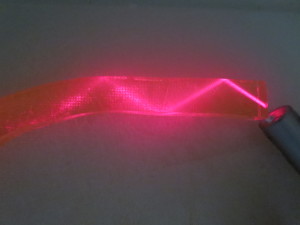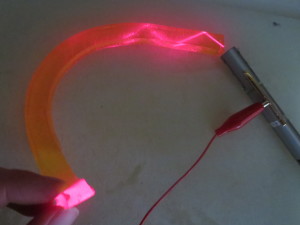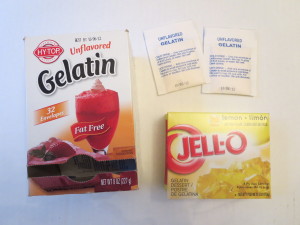A fiber optic cable must have a core that is more optically-dense than the layer surrounding the core (the cladding.) If the light is traveling inside the core and hits the boundary between the core and the cladding, it can completely reflect from that boundary instead of passing through the boundary and out into the cladding. When this happens, the light will bounce back and forth inside the core, even traveling around curves! This process is called “total internal reflection.”
 Total internal reflection can be observed by making a “fiber optic cable” out of Jello. Jello is more optically dense than air, so the Jello will be the core, and the air surrounding the Jello will be the cladding. By aiming a laser pointer into the end of the Jello fiber optic cable, you can find some angles of incoming light that will produce total internal reflection. (It helps to do this in a darkened room.)
Total internal reflection can be observed by making a “fiber optic cable” out of Jello. Jello is more optically dense than air, so the Jello will be the core, and the air surrounding the Jello will be the cladding. By aiming a laser pointer into the end of the Jello fiber optic cable, you can find some angles of incoming light that will produce total internal reflection. (It helps to do this in a darkened room.)

Although a strong beam can only be seen for a few reflections, the fact that the end of the “cable” is so bright indicates that most of the light has stayed inside the cable, traveling all the way to the end by total internal reflection.
Recipe for making a Jello Fiber Optic Cable
Ingredients
- 2 small packets unflavored Gelatin
- 4.5 ounces Lemon Jello (from a 6 oz box)
- 2 cups boiling water
Directions
Mix all ingredients together until powders are completely dissolved. Pour into a 9×13 Pyrex dish and refrigerate until firm. Cut into strips, about 1 cm wide, avoiding areas where the Jello is curved due to the shape of the Pyrex dish.

